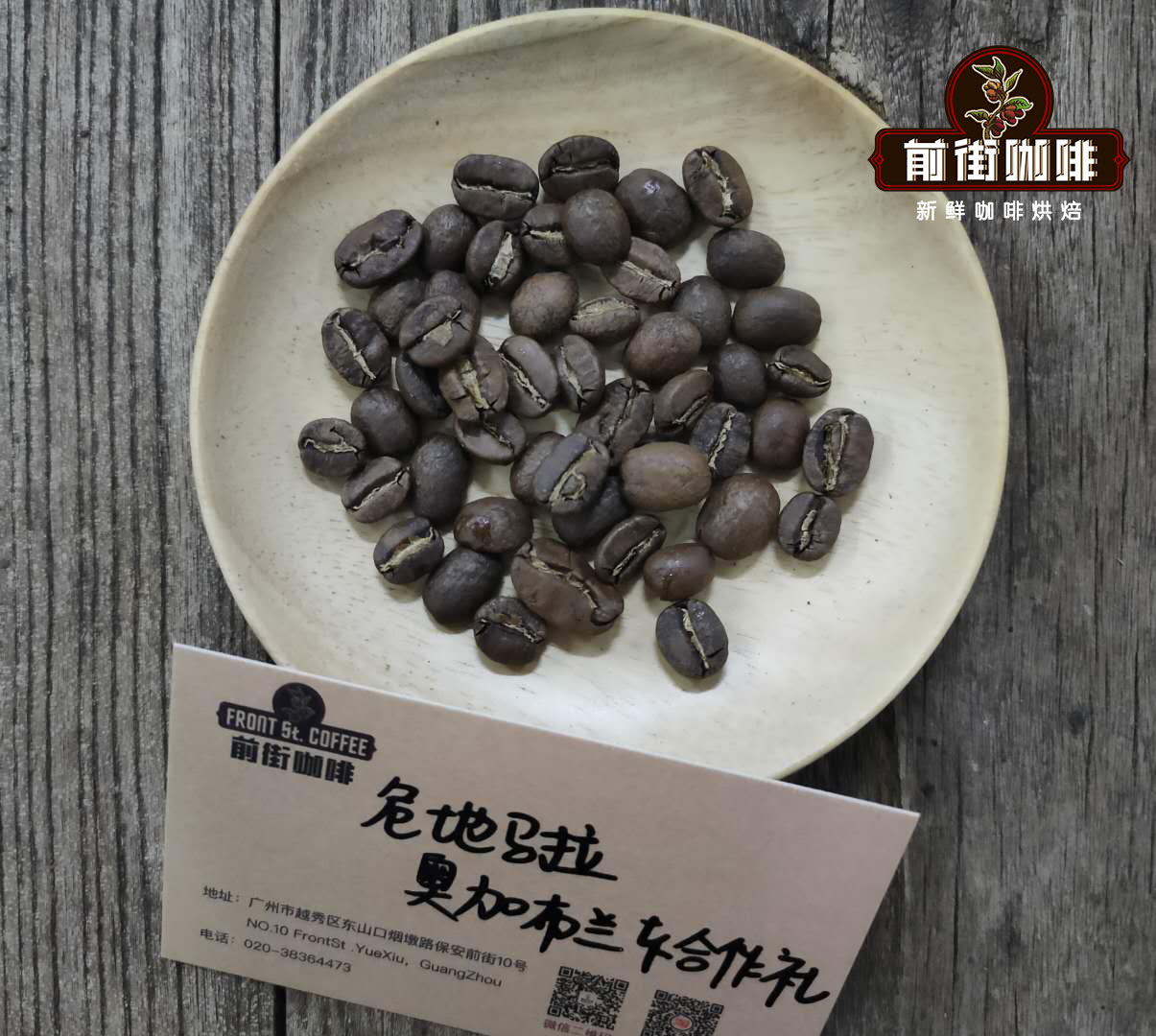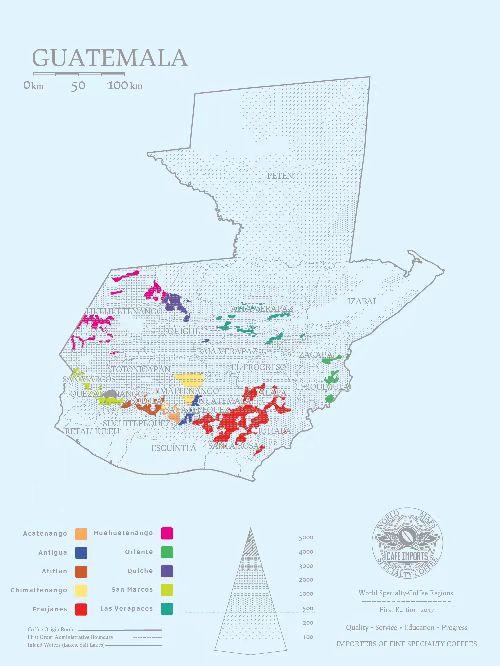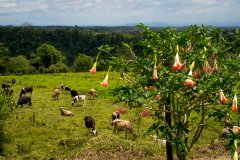Flavor characteristics of bourbon coffee beans with Vivetna fruit water in Guatemala eight major coffee producing areas in Guatemala
In most cases Guatemala has a well-functioning network of producers. Although infrastructure is still generally lacking (there is no national post office), coffee farmers are surprisingly well connected. This is largely due to the efforts of Anacaf é (Asociaci ó n Nacional del Caf é), a trade group that supports coffee growers.
Anacaf é creates brands in eight growing areas: Arcatel Nango Valley, Antigua Coffee, traditional Attland, Rainforest Copan, Flagane Plateau, Huwe Heights, New Oriental and San Marcos volcano.
Front Street Coffee most Guatemalan coffee comes from Vivette Nan Fruit producing area. Take one of them, for example: this Guatemalan Vivette Nango Oga Blanca washed bourbon Kaddura. The front street is moderately baked, with berries, soft acidity, smoky, smooth and balanced flavors.

Acatenango Valley
Through the Fuego and Acatenango volcanoes to the west of Antigua is the Acatenango Valley, where coffee grows on steep slopes up to 2000 meters high, in the thick shade of trees. The frequent eruption of nearby Fuego volcano makes the rough sandy soil full of minerals, while Gravilea (Gravillearobusta), Cuje (Inga sp.) And the shade of Guachip í n (Diphysa americana) regulates the temperature and creates habitats for a variety of animals and plants.
Mild gusts from the Pacific and obvious seasons allow coffee to dry in the sun, and the process follows ancient family traditions.
The United Acatenango Coffee Growers Association was established in 2006 to delineate and recognize the uniqueness of the region and obtained the name of origin of the coffee in the region in 2012. The geographical area of Caf é Acatenango covers an area of 9663 hectares, all in the province of Chimaltenango.
The varieties commonly grown in the region are Caturra, Bourbon and Catua í. Coffee is traditionally picked and sorted by hand, fully washed and dried. More information can be found here.
Average harvest time: December to mid-March
Atitl á n
Among the five volcanic coffee producing areas in Guatemala, Atitl á n has the highest content of soil organic matter. 90% of the Atitl á n certified coffee is grown along the slope of the spectacular Fire Mountain that occupies the shores of Lake Atitl á n. The daily wind that stirs the cold lake water (called Xocomil) has an important impact on the microclimate. The highly developed craftsman tradition of culture is reflected in the skilled planting and processing of small producers.
Average harvest time: December to mid-March
Coban Coba á n
The annual precipitation is about 3500 mm, with nine to ten months of regular rainfall in a year. Continuous rain (most of which is mild drizzle / mist, locally known as chipichipi) means that the flowers are very staggered, 8-9 times a year. Due to prolonged flowering, coffee ripens at different stages, which means that up to 10 passes (14 days apart) are needed to ensure that only the most ripe cherries are selected.
The cool and rainy climate makes it difficult to dry coffee in Koban, and traditional mechanical drying is already common. Nevertheless, Copan is home to some of the most innovative and loyal coffee producers in Guatemala, many of whom have made great strides in drying experiments under challenging conditions and in producing some of the best coffee that Guatemala must provide.
Average harvest time: December to March
Fraijanes Plateau
Volcanic pumice soil, very high altitude, abundant Rain Water, changeable humidity and active volcanoes are the characteristics of the area. The Pacaya volcano, the most active of the three eruptive volcanoes in Guatemala, often provides the region with a small amount of ash and important minerals for the soil. The dry season is characterized by plenty of sunshine, and although there are often clouds, fog and dew early in the morning, they soon burn up, drying the entire Flagane plateau.
Average harvest time: December to February

Huehuetenango
Among the three non-volcanic areas, Huehuetenango is the highest and driest coffee producing area. Thanks to the dry, hot wind blowing into the mountains from the Twantepec Plain in Mexico, the area is protected from frost, allowing the highlands to grow up to 6500 feet (2000 meters) of Huehue. These high elevations and relatively predictable climates create excellent boutique coffee.
Huehuetenango is so remote that almost all producers are required to process their own coffee. Fortunately, the area has an almost unlimited number of rivers and streams, so factories can be placed almost anywhere.
Average harvest time: January to April
Nueva Oriente
In the region, coffee has been grown almost entirely by small producers since the 1950s. Today, almost every farm on the mountain has become a coffee production unit, once one of the poorest and most remote areas in Guatemala, which is vibrant and growing. Rainy and cloudy, Oriente is located in the former volcanic mountains. Its soil is made up of metamorphic rock: mineral balance, which is very different from the soil in areas where volcanic activity has been frequent since coffee was planted.
Average harvest time: December to March
San Marcos San Marcos
San Marcos, the warmest of the eight coffee-growing areas, also has the highest rainfall, up to 200inches (5000 mm). Seasonal rainfall comes earlier than other areas and blossoms the earliest.
Like all remote areas of Guatemala, most of the coffee in San Marcos is grown on farms with their own processing plants. Due to the unpredictability of rainfall during the harvest season, most of the coffee is pre-dried in the sun and then finished in a Guardiola (mechanical) dryer.
Average harvest time: December to March
Important Notice :
前街咖啡 FrontStreet Coffee has moved to new addredd:
FrontStreet Coffee Address: 315,Donghua East Road,GuangZhou
Tel:020 38364473
- Prev

Traditional Kenyan coffee bean processing methods flavor Kenyan Kiambu coffee growers team story
Grower groups such as Ngewa-Komothai help quality-conscious small owners maintain quality and traceability standards while entering the international market
- Next

Deborah Manor Natural nitrogen impregnation method Rosa Coffee beans Flavor characteristics pressure anaerobic treatment?
I saw a tweet from Deborah Manor on ins the other day, introducing the joint product with corvuscoffee and starting to savage geisha coffee beans. According to the official website, this is an extremely limited product that will experience a subversion of the definition of coffee. With these super gardening prostitutes from Finca Deborah, you will get a new perspective on innovation in the wine industry.
Related
- Detailed explanation of Jadeite planting Land in Panamanian Jadeite Manor introduction to the grading system of Jadeite competitive bidding, Red bid, Green bid and Rose Summer
- Story of Coffee planting in Brenka region of Costa Rica Stonehenge Manor anaerobic heavy honey treatment of flavor mouth
- What's on the barrel of Blue Mountain Coffee beans?
- Can American coffee also pull flowers? How to use hot American style to pull out a good-looking pattern?
- Can you make a cold extract with coffee beans? What is the right proportion for cold-extracted coffee formula?
- Indonesian PWN Gold Mandrine Coffee Origin Features Flavor How to Chong? Mandolin coffee is American.
- A brief introduction to the flavor characteristics of Brazilian yellow bourbon coffee beans
- What is the effect of different water quality on the flavor of cold-extracted coffee? What kind of water is best for brewing coffee?
- Why do you think of Rose Summer whenever you mention Panamanian coffee?
- Introduction to the characteristics of authentic blue mountain coffee bean producing areas? What is the CIB Coffee Authority in Jamaica?

